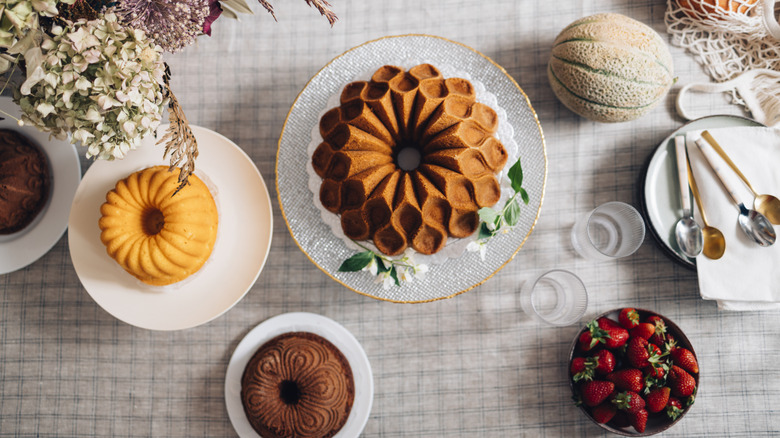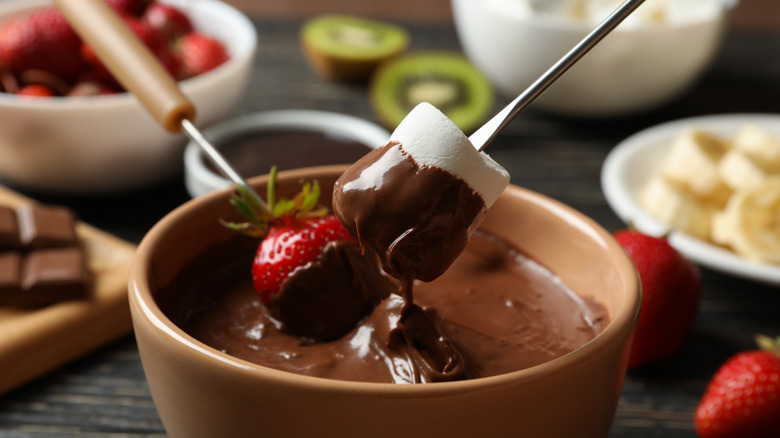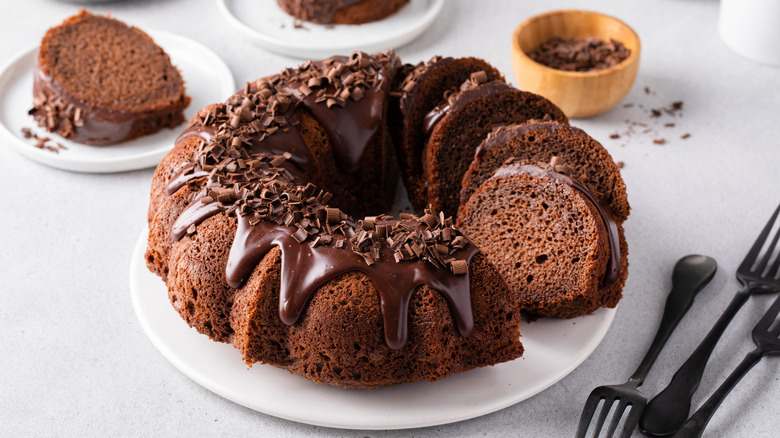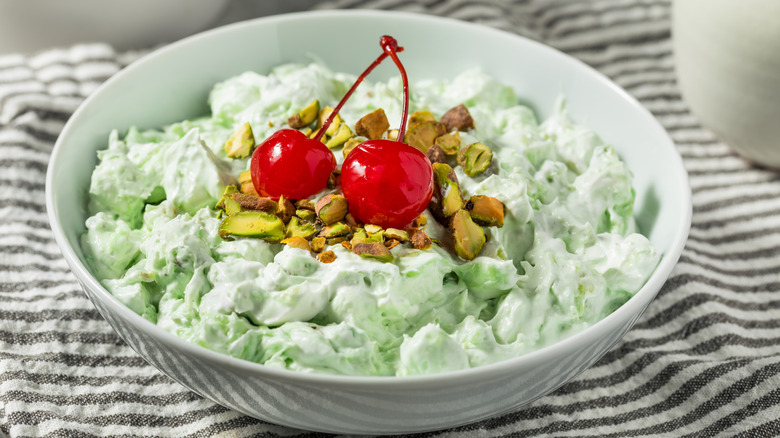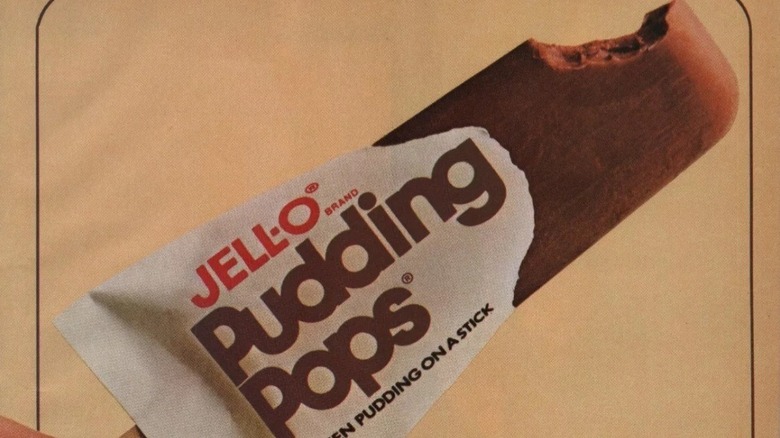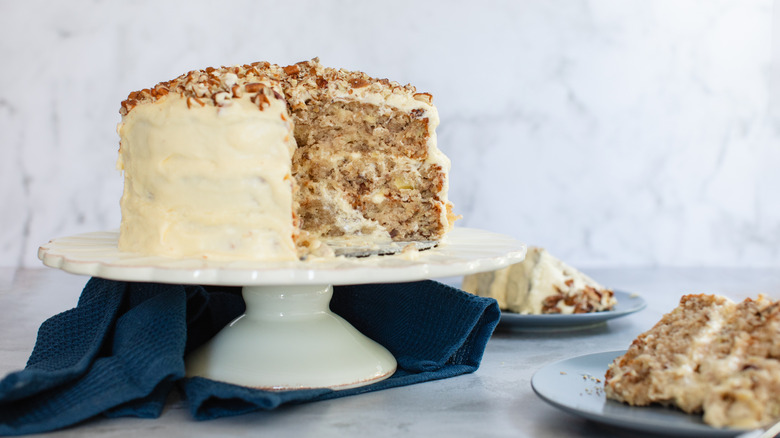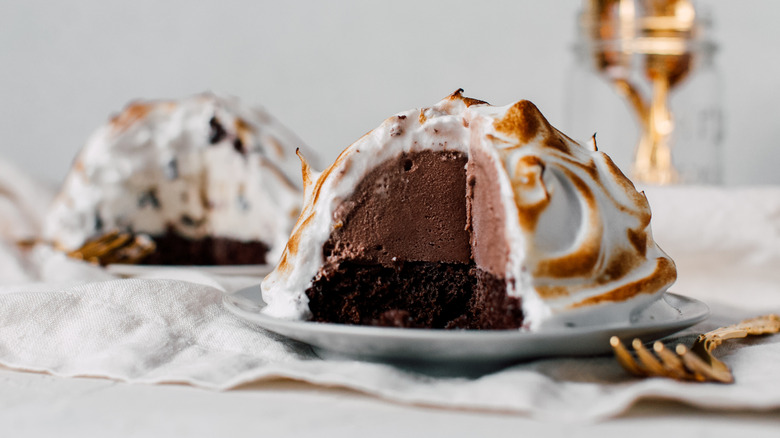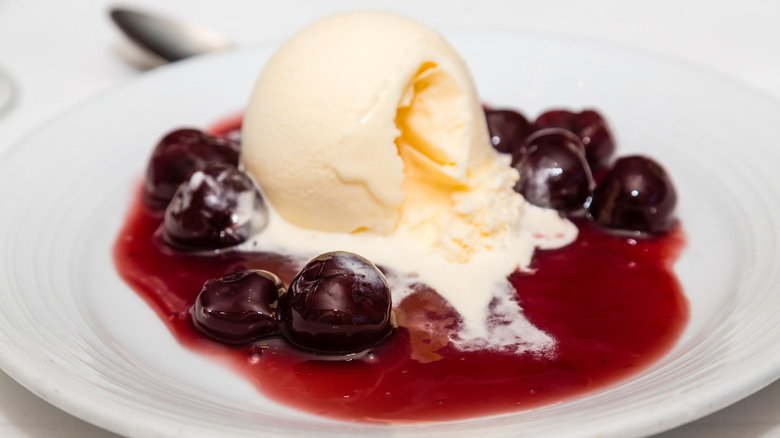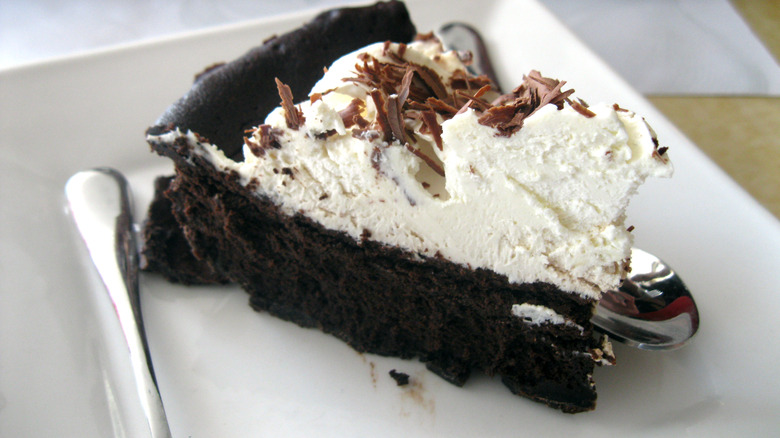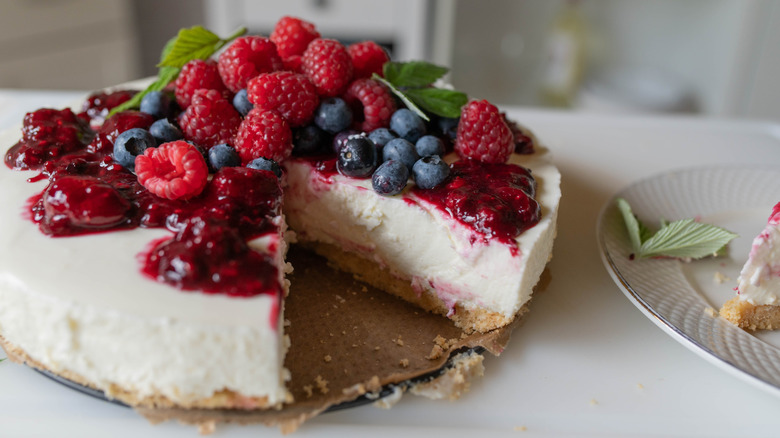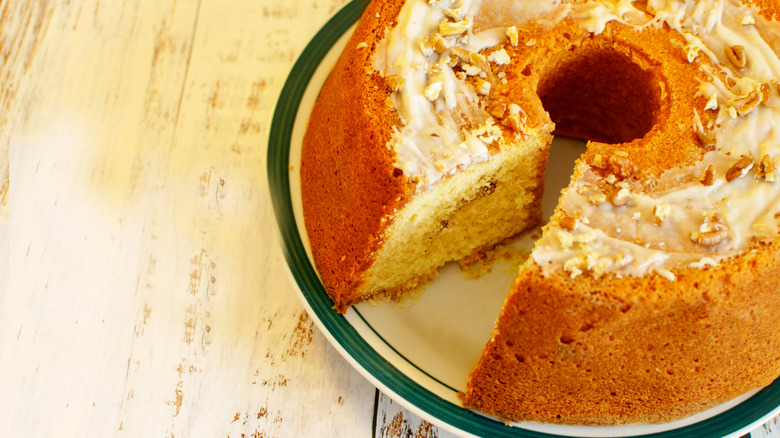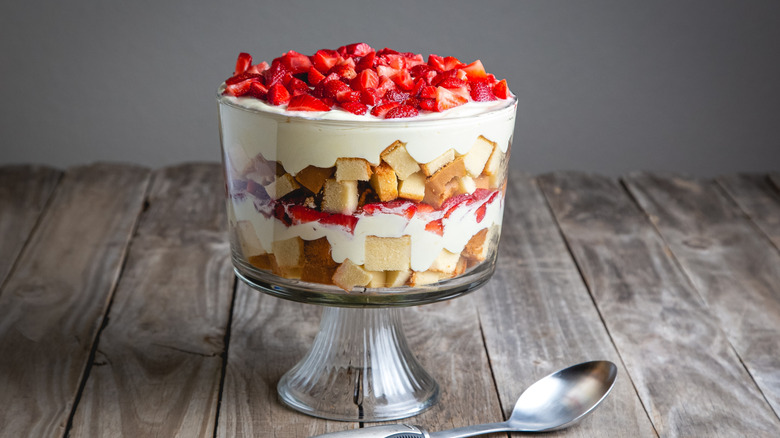12 Vintage Desserts That People Loved In The '70s
Like fashion, music, and hairstyles, food goes through trends. Remember the era of low-fat everything in the 1990s? Or the proliferation of cupcake shops in the 2000s? More recently, maybe you recall when every brand under the sun had to try their hand at adding food dye and glitter to food to keep up with the unicorn trend? The 1970s weren't immune to their own fads, and beyond the wide lapels and feathered hair, there was also lots of flashy appeal to certain desserts.
Society was shifting in the '70s, with more women entering the workforce and developing increased economic and social freedoms — and, of course, the introduction of the microwave, which made food preparation much simpler. Convenience foods went toe-to-toe with more elaborate dishes and international influences (hello French cuisine), and began to pop up in American kitchens. The 1970s were a decade of exploration, and that certainly included food.
While some of these vintage desserts had been around since long before the decade, they seemed to hit their stride during these years. Others were completely unique creations, brought about with a little creativity and ingenuity. From the spectacle of the baked Alaska to the advantage of instant pudding mixes, there was something for everyone to satisfy their sweet tooth in the 1970s.
Chocolate Fondue
Ideal for dinner parties or get-togethers, fondue became popular among adults during the 1970s, not least of all because it involved a whole lot of melted chocolate. Originally a dish of Swiss descent in the 1930s that involved a giant vat of melted cheese — although it can be traced back to much earlier — fondue first became popular in the United States in the mid-1960s, as both a sweet and savory dish.
This dessert was an easy option for even the most novice bakers, mostly because it only required assembly, with guests doing the actual "cooking" part. A pot or bowl of chocolate was heated over an open flame until it became deliciously melted. Some chefs even liked to add more international flair –– and orange flavor –– by throwing in a dash of Grand Marnier to the mix. Then, guests could use whatever they liked for dipping, holding long forks that typically came with a fondue set. Everything from fresh fruit to cubes of cake to marshmallows was fair game in this fun, interactive dessert.
Bundt Cake
More a style of dessert than a single dessert in particular, bundt cakes were extremely popular in the 1970s. The shape of the bundt pan features fluted or grooved sides in the shape of a ring, with a hole in the middle. (Its shape can also lead to difficulty with releasing a cake from the pan, unless you know this dipping trick.) While the pan first arrived on the scene in 1950, it was initially so unpopular that the company that created it –– Nordic Ware –– considered discontinuing it.
It wasn't until 1966 that bundt pans really took off, thanks to the winning recipe in the Pillsbury Bake-Off: a decadent, chocolatey masterpiece known as the "Tunnel of Fudge Cake" that used the iconic bundt shape to its gastronomic advantage. The successful cake recipe led to an increase in demand for bundt cake pans, and Pillsbury bought the license to the name, releasing a series of cake mixes for exclusive use with bundt pans. Now, bundt cakes seem a bit passé, even if they are delicious, but they do still hold a certain retro appeal.
Watergate Salad
It's not often you get a dessert named after a political scandal, but the 1970s were a time of reinvention and a pistachio confection known as Watergate salad was not immune. The name "Watergate salad" is actually a bit of a misnomer, as this dish certainly isn't a health food chock full of veggies and leafy greens –– it's a dessert. Also known as "Pistachio Delight," this salad came around after the introduction of Kraft Foods' pistachio-flavored instant pudding mix. The salad also contains roasted pistachios, canned pineapple, Cool Whip, and marshmallows.
Popular among Midwesterners and potlucks during the decade, this dessert salad is fluffy, creamy, and perhaps a little strange. The 1970s were a time when people threw caution to the wind, and that includes their food. Watergate salad wasn't the first salad to include marshmallows, and it definitely wasn't the last. (Another dessert with a similar name and containing pistachios was Watergate cake, a confection that featured pistachio in the sponge as well as the frosting that was popular during the same period.)
Jell-O Pudding Pops
Sure, you could freeze some pudding in molds or jam a popsicle stick through the foil lid of your favorite Snack-Pak. You could even call them Jell-O Pudding Pops, but we all know those DIY creations wouldn't quite match up to the real thing. Jell-O Pudding Pops were first introduced in Louisiana in the 1970s, even if they didn't become an iconic dessert until the 1980s.
The creamy, portable desserts gained traction in the 1970s and soared in popularity the following decade. Alas, all good things must come to an end. Jell-O found that, despite the profitability of the Pudding Pops, they weren't quite successful enough to mitigate the cost of production. In 2004, the company discontinued Jell-O Pudding Pops, leaving us forever chasing that rich, creamy, sweet taste.
Hummingbird Cake
Originating in the late 1960s in Jamaica, hummingbird cake was created due to the abundance of bananas and pineapples in the country — two sweet ingredients that made for a delicious, moist cake. The name, likewise, comes from Jamaica: The hummingbird is the country's national bird.
However, it wasn't until the 1970s that Americans took note of the simple deliciousness of the cake, and shortly afterward, it became a Southern classic, trotted out at everything from dinner parties to state fairs. The first publication for hummingbird cake was in 1978, when it appeared in Southern Living magazine as a submission from a North Carolina resident. It has since gone on to become the most-requested recipe in the magazine's history. With its tender layers, warm spice profile (hummingbird cake is usually flavored with cinnamon, nutmeg, and vanilla), crunchy roasted pecans, and rich cream cheese frosting, this cake has moved beyond the 1970s and is still a beloved dessert even today.
Baked Alaska
A stunner of dessert that epitomized the glamour of the 1970s, baked Alaska was an ambitious creation that featured a solid dome of ice cream atop a layer of cake that was all covered in a coat of whipped meringue and torched to golden perfection. The dish required a level of skill and precision that wasn't for the faint of heart. After all, you had to brown the meringue without letting the ice cream melt, keeping the cold component still chilled within the fluffy meringue igloo. Even more intense: Splashing a bit of rum all over the whole confection and lighting it on fire, a process that transformed "baked Alaska" into "bombe Alaska."
While it's believed that baked Alaska first entered the scene in the 19th century, it was in the second half of the 20th that it really caught on. The "wow" factor of this dessert had a hold on restaurant diners in the 1970s, where a degree of showmanship was required with this dessert. Unfortunately, since its heyday, baked Alaska has faded from restaurant menus and isn't a dish many novice bakers like to take on.
Instant Pudding
In stark contrast to the meticulousness required to make baked Alaska, convenience was the name of the game where instant pudding was concerned. Although introduced in 1918 by a company called My-T-Fine, the popularity of instant pudding increased in the 1960s and 1970s. It was an easy dessert to have on hand to whip up whenever you needed a sweet treat, came in a wide variety of flavors, like vanilla, tapioca, coconut, pistachio, and butterscotch. Plus, it was incredibly cheap, even by today's standards. (Instant pudding is also the secret ingredient for an extra-moist boxed cake.)
In addition to Jell-O, which began manufacturing instant pudding in 1936, a company called Bird's Custard joined the instant dessert craze. Around since the 1800s, Bird's waited until 1967 to release Angel Delight, an instant dessert mix with an airy, mousse-like texture. The demand was certainly there – by the 1970s, Bird's had doubled the market for instant desserts.
Cherries Jubilee
Like the Bombe Alaska, cherries jubilee had the benefit of showmanship that led to its popularity during the 1970s. The dessert was comprised of cherries in syrup and liquor –– traditionally kirsch, a cherry liqueur, but sometimes whiskey or brandy –– flambéed in a pan and served table side, often over vanilla ice cream.
It's generally believed that the dish first appeared in 1897, created as a celebratory dessert for Queen Victoria's Diamond Jubilee. Fast-forward to the 1970s, however, and the dessert was a mainstay at fine dining restaurants for customers who appreciated the theatrics that went into making it. (In fact, it even made a recent appearance in the 1970s-set Oscar-winning film "The Holdovers.") Like other desserts that were set alight, including bananas foster and peach melba, cherries jubilee had its heyday in mid-century America before its allure began to peter out sometime in the 1980s, relegated to being kitschy instead of classy.
Mississippi Mud Pie
Maybe the name isn't the most appetizing, but the dessert is. A must-try for the chocoholics among us, Mississippi mud pie is much more down to earth on the dessert front, the kind of treat that any home baker could mix up whenever the desire arose. Traditionally, this sweet treat began with a chocolate pie crust that was then filled with chocolate pudding, but there were also layers of whipped cream, marshmallows, chocolate sauce, and chocolate shavings. Some bakers would also skip the pie crust portion entirely and make "Mississippi mud cake" instead, an ooey-gooey confection that would leave even the staunchest sweet tooth in a sugar coma.
While the exact origins of Mississippi mud pie are a bit unclear, many seem to think that it began in the 1970s as a reinvention of Mississippi mud cake. The decade was certainly the time when this Southern treat became popular, with enough opportunities for customization (including the addition of biscuits, brownies, nuts, coffee, and liquor) that no one can complain about this chocolate treat.
No-Bake Cheesecake
In its third appearance on our list of vintage desserts people loved in the 1970s, Jell-O strikes again. Convenience was a huge selling point for the instant dessert mix behemoth, but the brand didn't want to limit itself to simple pudding and gelatin. In 1972, Jell-O advertised a recipe for a no-bake cheesecake made using its instant pudding and pie filling mix. Marketing it as the perfect dessert for summer, since bakers wouldn't have to turn on the oven, it appealed to those who wanted to make something a little more special –– but no less simple.
Typical no-bake cheesecakes use gelatin to set their ingredients, rather than a low-and-slow baking method and a water bath of the classic cheesecake. It makes perfect sense, then, that Jell-O would seize the opportunity to grab another corner of the dessert market by offering customers delicious recipes for no-bake treats like this one using its own proprietary ingredient. Now, no-bake desserts (like this one for Cherry Delight), are pretty common among both novice and expert bakers alike.
Sock-It-To-Me Cake
Have you ever had a dessert that was so delicious, so memorable and crave-worthy that when someone offered you a second slice, you cried, "Sock it to me?" Probably not, unless you're a big fan of vintage slang, but the sentiment may remain the same.
A bundt cake or tube cake with a memorable name, the Sock-It-To-Me Cake was an invention of a company behind many boxed cake mixes lining store shelves and home pantries: Duncan Hines. The brand printed the recipe on the back of boxes of its Classic Butter Golden Cake Mix in the 1970s and named it for a cheeky retro phrase that would hopefully see customers demand more than one piece. The cake itself was a moist, golden yellow cake with a layer of cinnamon-spiced pecans running throughout the middle. It was then finished with a warm drizzle of vanilla frosting before being sliced and served. So popular has this dessert remained that the recipe still exists on the Duncan Hines website today.
Berry Trifle
Elegant, deceptively fancy, and a breeze to make, berry trifles were popular in the 1970s for a variety of reasons. First, they looked sophisticated, arranged in a tall trifle dish with visible layers. Second, they were deceptively simple. In an era dominated by convenience foods and pantry staples, berry trifle could be made with zero actual baking. Store-bought cake sliced into cubes, canned whipped cream (or Cool Whip), instant pudding or custard, and fresh berries formed this easy, shareable dessert.
Trifles have been around for hundreds of years, first appearing in England in the 18th century, albeit in a slightly more complicated format. The style of trifle that was popular in the 1970s among Americans was decidedly less complex. Bird's Custard specialized in instant desserts, offered a trifle mix during this decade, and it was a popular dessert in vintage cookbooks to impress guests at dinner parties. Another part of the appeal of the trifle was that you could choose your cake flavor, fruit variety, and custard or pudding to suit your –– or your guests' –– taste buds.
